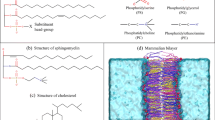Abstract
Alamethicin is an antibiotic peptide comprising 20 amino acid residues and functions as an ion channel in biological membranes. Natural alamethicins have a variety of amino acid sequences. Two of them, used as a mixed sample in this study, are: UPUAUAQUVUGLUPVUUQQO and UPUAUUQUVUGLUPVUUQQO, where U and O represent α-aminoisobutyric acid and phenylalaninol, respectively. As indicated, only the amino acid at position six differs, and the two alamethicins are referred to as alamethicin-A6 and -U6, respectively. The conformation and thermal stability of alamethicin-A6 and -U6 in methanol were examined using proton nuclear magnetic resonance (NMR) spectroscopy. Both alamethicins form an α-helix between the 2nd and 11th residues. The N-terminal, 19th and C-terminal residues take a non-helical conformation. The structure between the 12th and 18th residues has not been well determined due to the absence of cross peaks in the two-dimensional NMR data. The α-helices are maintained up to 54 °C at least. In contrast to these similarities, it has been found that the length of the α-helix of alamethicin-U6 is somewhat shorter than that of alamethicin-A6, the intra-molecular hydrogen bonds formed by the amide proton of the seventh residue is much more thermally stable for alamethicin-U6 than for alamethicin-A6, and the C-terminal residue of alamethicin-U6 has higher mobility than that of alamethicin-A6. The mobility of the N- and C-terminal residues is discussed on the basis of a model chain which consists of particles connected by rigid links, and the physiological significance of the mobility is emphasized.











Similar content being viewed by others
References
Biggin PC, Breed J, Son HS, Sansom MSP (1997) Simulation studies of alamethicin-bilayer insertions. Biophys J 72:627–636
Cafiso DS (1994) Alamethicin: a peptide model for voltage gating and protein-membrane interactions. Annu Rev Biophys Biomol Struct 23:141–165
Chugh JK, Wallace BA (2001) Peptaibols: models for ion channels. Biochem Soc Trans 29:565–570
Dempsey CE (1995) Hydrogen bond stabilities in the isolated alamethicin helix: pH-dependent amide exchange measurements in methanol. J Am Chem Soc 117:7526–7534
Duclochier H, Wrόblewski H (2001) Voltage-dependent pore formation and antimicrobial activity by alamethicin and analogues. J Membr Biol 184:1–12
Esposito G, Carver JA, Boyd J, Campbell ID (1987) High-resolution 1H NMR study of the solution structure of alamethicin. Biochemistry 26:1043–1050
Fox RO Jr, Richards FM (1982) A voltage-gated ion channel model inferred from the crystal structure of alamethicin at 1.5-Å resolution. Nature 300:325–330
Franklin JC, Ellena JF, Jayasinghe S, Kelsh LP, Cafiso DS (1994) Structure of micelle-associated alamethicin from 1H NMR. Evidence for conformational heterogeneity in a voltage-gate peptide. Biochemistry 33:4036–4045
He K, Ludtke SJ, Heller WT, Huang HW (1996) Mechanism of alamethicin insertion into lipid bilayers. Biophys J 71:2669–2679
Huang HW, Chen FY, Lee MT (2004) Molecular mechanism of peptide-induced pores in membranes. Phys Rev Lett 92:198304(1–4)
Kelsh LP, Ellena JF, Cafiso DS (1992) Determination of the molecular dynamics of alamethicin using 13C NMR: implications for the mechanism of gating of a voltage-dependent channel. Biochemistry 31:5136–5144
Kirschbaum J, Krause C, Winzheimer RK, Brückner H (2003) Sequences of alamethicins F30 and F50 reconsidered and reconciled. J Pept Sci 9:799–809
Kleckner IR, Foster MP (2011) An introduction to NMR-based approaches for measuring protein dynamics. Biochim Biophys Acta 1814:942–968
Konishi T, Yanagita T (2009) Energetic motion of end-particles in constrained dynamical systems. J Stat Mech L09001:1–9
Leitgeb B, Szekeres A, Manczinger L, Vágvölgyi C, Kredics L (2007) The history of alamethicin: a review of the most extensively studied peptaibol. Chem Biodivers 4:1027–1051
Nagao T, Mishima D, Javkhlantugs N, Wang J, Ishioka D, Yokota K, Norisada K, Kawamura I, Ueda K, Naito A (2015) Structure and orientation of antibiotic peptide alamethicin in phospholipid bilayers as revealed by chemical shift oscillation analysis of solid state nuclear magnetic resonance and molecular dynamics simulation. Biochim Biophys Acta 1848:2789–2798
Salditt T, Li C, Spaar A (2006) Structure of antimicrobial peptides and lipid membranes probed by interface-sensitive X-ray scattering. Biochim Biophys Acta 1758:1483–1498
Sansom MSP (1993) Structure and function of channel-forming peptaibols. Q Rev Biophys 26:365–421
Tieleman DP, Breed J, Berendsen HJC, Sansom MSP (1998) Alamethicin channels in a membrane: molecular dynamics simulations. Faraday Discuss 111:209–223
van de Ven FJM (1995) Multidimensional NMR in Liquids: Basic Principles and Experimental methods. Wiley-VCH, New York
Voet D, Voet JG (1990) Biochemistry. Wiley, New York
Wüthrich K (1986) NMR of proteins and nucleic acids. Wiley, New York
Yee AA, O’Neil JDJ (1992) Uniform 15N labeling of a fungal peptide: the structure and dynamics of an alamethicin by 15N and 1H NMR spectroscopy. Biochemistry 31:3135–3143
Yee AA, Babiuk R, O’Neil JDJ (1995) The conformation of an alamethicin in methanol by multinuclear NMR spectroscopy and distance geometry/simulated annealing. Biopolymers 36:781–792
Yee AA, Marat K, O’Neil JDJ (1997) The interactions with solvent, heat stability, and 13C-labelling of alamethicin, an ion-channel-forming peptide. Eur J Biochem 243:283–291
Author information
Authors and Affiliations
Corresponding author
Additional information
Publisher's Note
Springer Nature remains neutral with regard to jurisdictional claims in published maps and institutional affiliations.
Rights and permissions
About this article
Cite this article
Miura, Y. NMR studies on the conformation, stability and dynamics of alamethicin in methanol. Eur Biophys J 49, 113–124 (2020). https://doi.org/10.1007/s00249-019-01418-8
Received:
Revised:
Accepted:
Published:
Issue Date:
DOI: https://doi.org/10.1007/s00249-019-01418-8




